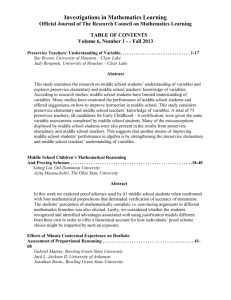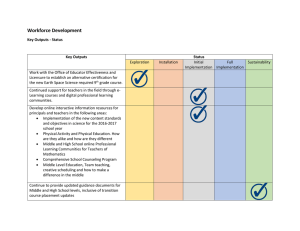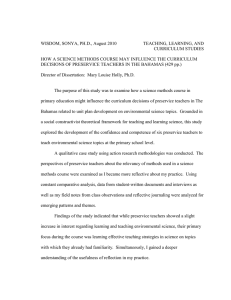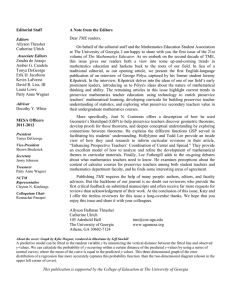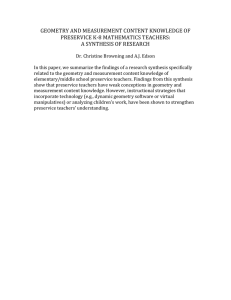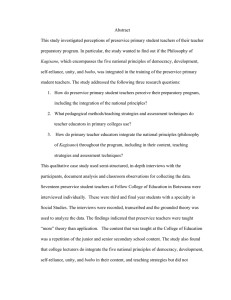Getting Everyone Involved in Family Math Melissa R. Freiberg
advertisement
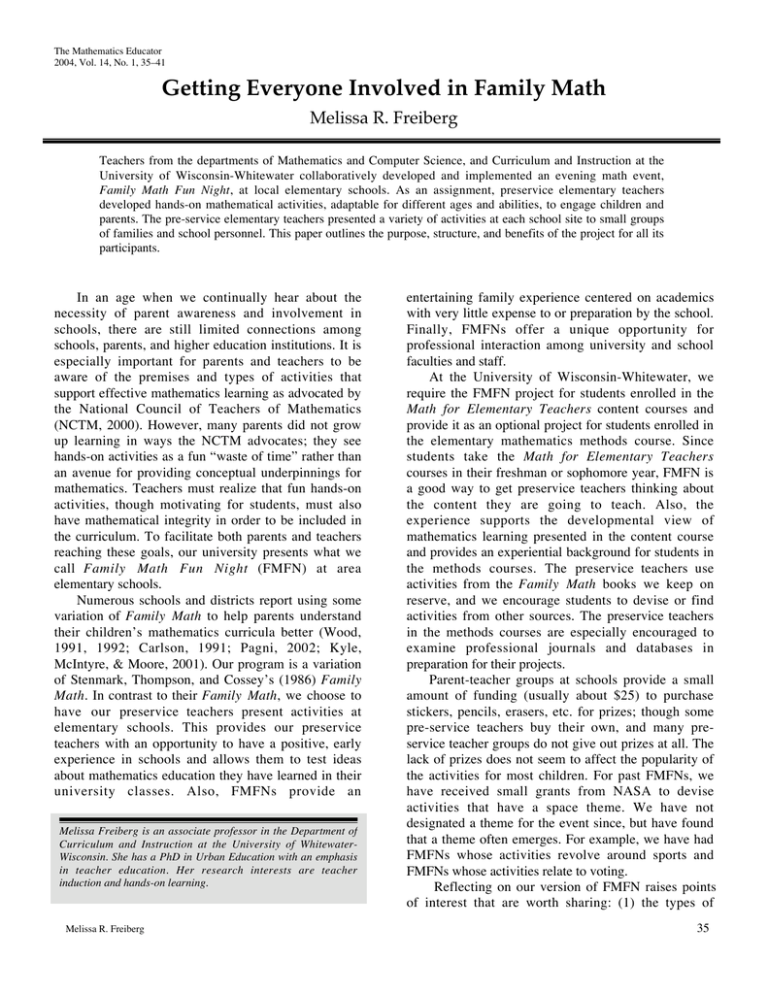
The Mathematics Educator 2004, Vol. 14, No. 1, 35–41 Getting Everyone Involved in Family Math Melissa R. Freiberg Teachers from the departments of Mathematics and Computer Science, and Curriculum and Instruction at the University of Wisconsin-Whitewater collaboratively developed and implemented an evening math event, Family Math Fun Night, at local elementary schools. As an assignment, preservice elementary teachers developed hands-on mathematical activities, adaptable for different ages and abilities, to engage children and parents. The pre-service elementary teachers presented a variety of activities at each school site to small groups of families and school personnel. This paper outlines the purpose, structure, and benefits of the project for all its participants. In an age when we continually hear about the necessity of parent awareness and involvement in schools, there are still limited connections among schools, parents, and higher education institutions. It is especially important for parents and teachers to be aware of the premises and types of activities that support effective mathematics learning as advocated by the National Council of Teachers of Mathematics (NCTM, 2000). However, many parents did not grow up learning in ways the NCTM advocates; they see hands-on activities as a fun “waste of time” rather than an avenue for providing conceptual underpinnings for mathematics. Teachers must realize that fun hands-on activities, though motivating for students, must also have mathematical integrity in order to be included in the curriculum. To facilitate both parents and teachers reaching these goals, our university presents what we call Family Math Fun Night (FMFN) at area elementary schools. Numerous schools and districts report using some variation of Family Math to help parents understand their children’s mathematics curricula better (Wood, 1991, 1992; Carlson, 1991; Pagni, 2002; Kyle, McIntyre, & Moore, 2001). Our program is a variation of Stenmark, Thompson, and Cossey’s (1986) Family Math. In contrast to their Family Math, we choose to have our preservice teachers present activities at elementary schools. This provides our preservice teachers with an opportunity to have a positive, early experience in schools and allows them to test ideas about mathematics education they have learned in their university classes. Also, FMFNs provide an Melissa Freiberg is an associate professor in the Department of Curriculum and Instruction at the University of WhitewaterWisconsin. She has a PhD in Urban Education with an emphasis in teacher education. Her research interests are teacher induction and hands-on learning. Melissa R. Freiberg entertaining family experience centered on academics with very little expense to or preparation by the school. Finally, FMFNs offer a unique opportunity for professional interaction among university and school faculties and staff. At the University of Wisconsin-Whitewater, we require the FMFN project for students enrolled in the Math for Elementary Teachers content courses and provide it as an optional project for students enrolled in the elementary mathematics methods course. Since students take the Math for Elementary Teachers courses in their freshman or sophomore year, FMFN is a good way to get preservice teachers thinking about the content they are going to teach. Also, the experience supports the developmental view of mathematics learning presented in the content course and provides an experiential background for students in the methods courses. The preservice teachers use activities from the Family Math books we keep on reserve, and we encourage students to devise or find activities from other sources. The preservice teachers in the methods courses are especially encouraged to examine professional journals and databases in preparation for their projects. Parent-teacher groups at schools provide a small amount of funding (usually about $25) to purchase stickers, pencils, erasers, etc. for prizes; though some pre-service teachers buy their own, and many preservice teacher groups do not give out prizes at all. The lack of prizes does not seem to affect the popularity of the activities for most children. For past FMFNs, we have received small grants from NASA to devise activities that have a space theme. We have not designated a theme for the event since, but have found that a theme often emerges. For example, we have had FMFNs whose activities revolve around sports and FMFNs whose activities relate to voting. Reflecting on our version of FMFN raises points of interest that are worth sharing: (1) the types of 35 activities that are presented at the events and what determines their quality, (2) what considerations are necessary for coordinating a FMFN, and (3) what can be learned as a result of the experiences. In the following sections, I will attend to each of these categories. Types of Activities For each school site, the university organizers provide two activities in addition to those the preservice teachers present. The first activity uses jars containing snacks that are taken to the school a week prior to the FMFN. Jars of varying shape are used for different age levels. Each class within an age level estimates the number of snacks in the jar and records its estimate. During the FMFN, individual students or parents can make estimates and enter them for a particular class. The class with the closest estimate receives the snacks. This activity serves two purposes. The first purpose is to generate interest in and awareness of the event and encourage participation. The second purpose is to support NCTM’s efforts (NCTM, 2000) by emphasizing estimation skills. The second activity provided by the university requires a school representative to greet children and parents at the door and ask them to add a sticker to his or her birth month on a pre-designed bar graph. This helps take attendance for the evening and also helps children see the process of data collection and how a graph evolves from the process. Preservice teachers design all other activities, and their activities must involve mathematics concepts covered in their math classes (Math For the Elementary Teachers I—numeration, whole number and fraction operations, problem solving; Math For the Elementary Teacher II—geometry, measurement, probability, and statistics). The types of projects the preservice teachers choose to present usually fall into the categories of drill and practice, problem solving, or estimation. I will discuss types of activities that fall into each category and then discuss two exceptional activities that do not fall into any of the three categories. Drill and Practice Although students are charged (and monitored) to do more than BINGO or flash cards as the essence of the activity, drill and practice may be part of the activity. Pre-service teachers’ initial attempts at creating these activities are generally weak but with coaching or feedback, they develop more thoughtprovoking activities. Rich activities designed to 36 incorporate drill and practice are usually presented in the context of a game. For example, one student group used a plastic bowling set to practice: addition and subtraction facts with younger children, how to keep a running total with slightly older children, and how to identify fractions and percents for upper elementary children. Other examples of drill and practice activities are educational video games in which correct responses help students reach a goal (fuel for the spacecraft, money to buy souvenirs, moving closer to a target, etc.). These activities allow children to pick the difficulty of the task and move through different levels of calculation, building their self-confidence and knowledge. We encourage preservice teachers to broaden their activities to include topics such as geometry, estimation, logic, patterns, graph interpretation, and computation since all are important to review. Board games are yet another way to support drill and practice activity. The board is laid out on the floor so that students walk around it landing on spaces. When a student is on a space, he or she is asked a mathematics question that varies depending on the age of the student. Problem Solving Examples of problem solving activities are games from which preservice teachers create adaptations. Preservice teachers like to challenge themselves with games that incorporate mathematical ideas and skills and then adapt them to the skill level of the children. Adaptations of games such as Yahtzee® Equations® or 24® help children plan and carry out different strategies. Memory games, similar to Concentration® are used to match fractions to decimals, operations to results, or various representations of numbers. These games1 are inexpensive to produce, easy to explain, and easily adaptable for different ages and grade levels. A second example of a problem solving activity is asking children to identify or copy patterns in beads, pictures, tessellations, or shapes. Bead stringing is commonly used to demonstrate patterns. The youngest children describe and extend simple patterns while somewhat older children choose a preset pattern and string beads to illustrate the pattern. The oldest group of students designs bead strings that contain multiple patterns such as combining patterns of color with patterns of shape or size. This activity is more expensive because children keep the materials they use to make the bracelets or necklaces. Family Math Estimation In addition to the introductory snack estimation activity, almost every FMFN has at least one preservice teacher designed activity that asks children to estimate capacity, weight, area, and/or quantity. One popular activity requires children to estimate through the use of indirect measurement. In this activity, there are approximately 15 objects to measure and the characteristics of objects vary in difficulty according to children’s differing abilities. In recent years, we have seen a growing number of activities that use estimation to help students develop probability concepts. These activities illustrate our preservice teachers’ increased awareness of the importance of estimation and probability as well as their increased confidence in students’ abilities to do such activities. In these activities, children are asked how frequently an event happens or how close an estimated answer is to the correct solution. Exceptional Activities Two exceptional activities from the past do not fall into any of the above categories. They are exceptional because they are unique and demonstrate the creativity of the preservice teachers who made them. The first was presented in one of the first FMFNs we ran. Preservice teachers, with the help of the students, used math symbols to represent letters of each child's name on a nametag. Children were then told to see if they could figure out other people’s names by equating the letter of a name with a math symbol. For example, Anne's name might be + φ ≠ = (add, null set, not equal, equal) and she would then know the math symbol that corresponded to the letter “a”, “n”, and “e” and could use this to deduce the names of other people. The second exceptional activity had three pictures made up of geometric shapes. Children were given a paper shape and asked to match their paper shape with the shape in one of the pictures. The youngest children had shapes that were congruent to shapes in the picture, while older students were asked to find shapes similar to their shape but that differed in size, color, or orientation. The preservice teachers prompted children to name the shape and describe its attributes. This activity proved quite challenging for children but was extremely popular. Coordinating an FMFN In organizing FMFNs, we have discovered that communication among all the parties involved is essential. We have developed guidelines and a timeline to facilitate communication, to give schools and Melissa R. Frieberg preservice teachers a clear understanding of expectations, and to detail past problems we have faced. Since incorporating FMFN into our curriculum, we have identified objectives and assessments assuring that FMFN activities are mathematically sound (see Appendix A and Form A). The most frequent problems we encounter revolve around logistics such as coordinating transportation to schools, advertising the event in the community, and setting up the school space. The following steps are used to conduct our FMFN events and might be helpful for those who want to organize similar work: 1. Contact schools that might be interested in hosting the event. We contact school districts through direct mailings or use various connections our department has to area schools. After several years of conducting three FMFNs each semester, most schools contact us to schedule the event. 2. Information about FMFN is given to our preservice teachers with their class syllabus. The preservice teachers are allowed to choose the topic around which they will make their activity (within guidelines mentioned earlier). Groups may be made up of students from different classes requiring FMFN or from classes that offer it as an optional activity. 3. The preservice teachers turn in a description of their activities (see Form A and Evaluation Form) indicating how it will be adjusted for various ages/grades, how parents will be involved, and how they will assess the success of their activities. This allows the faculty to assess the activities for mathematical integrity and avoid redundancies in activities. It also gives students a foundation for writing their reflections on the event (See number 8). 4. We assign our preservice teachers to specific dates and schools based on preferences and class schedules. Groups are usually made up of three to four people and about twenty groups are assigned to each school. 5. We confirm who is assigned to each school and allow groups to indicate special set-up needs (see Form B). The preservice teachers indicate if they are able to provide transportation to the schools so car pools can be established. 6. A faculty member or preservice teacher visits each school to determine space and resource availability, to discuss the role of the school staff, and to give suggestions for advertising the event. We suggest the school connect FMFN with a regularly scheduled PTA meeting. Sending reminders home with school 37 children, having the event on the school calendar, and writing an article in the school or local newsletter explaining the event are ways that have been effective in bringing FMFN to the attention of parents. 7. The night of the event, university and school personnel monitor the preservice teacher groups and the families attending. At the close of the event, we announce the winning class for the estimation exercise and leave activity kits at the school for classroom use. 8. Each university preservice teacher group turns in a written reflection of impressions of the event. This report is not only helpful in assessing the university students' learning, but also helps us identify problems that might need to be addressed in the future. This report focuses on the content and success of the activity, how students handled problems and questions that arose, how students interacted with parents and teachers, and how they collaborated with their groups. 9. An individual report is also required from each preservice teacher. This report is focused on how the student felt the group process worked, what was learned about mathematics, and a self-reflection about one's ability as a teacher. Conclusions In the introduction, we stated that we found this activity to be beneficial to university preservice teachers, university faculty and staff, school staff, parents, and especially children. Although this paper is not intended to present a research study on FMFN, we believe that we have seen beneficial results for those involved. The university students have consistently, and almost unanimously, responded positively to their participation in FMFN both in their reports and in class discussions. Even students who described themselves as poor math students found the experience to be enjoyable and uplifting. They appreciated the chance to work with a small group of elementary students. As one student said, "I found that helping them [the children] out with solving a problem was an interesting and rewarding experience...this is what teaching is all about." Many university students were especially surprised and buoyed by the fact that they were able to adjust questions, offer hints and assistance, or explain mathematical ideas more easily than they anticipated. They also learned how to share responsibilities, ask for help, and make changes to their activities as needed. Too often preservice teachers believe these things are a sign of weakness rather than a sign of collaboration. FMFN helps change that perception. 38 One of the most rewarding results of this experience for the university faculty and staff is the opportunity to work collaboratively across departments and colleges. College of Education faculty/staff who teach the elementary mathematics methods courses assist faculty and staff from the Mathematics Department in planning, implementing, assessing, and revising the program. Additionally, the experience provides an opportunity for the Mathematics Department members to visit local elementary schools with teachers and children. Education faculty and staff who do regular supervision of student teachers in schools get to see students' abilities to teach to a variety of ages and abilities, which requires flexibility and instant adaptations that might be missed in single grade level settings. Teachers, administrators, and parents are effusive in their praise for the event. The university students mention that they often have classroom teachers waiting “like vultures” to pick up the activity at the end of the night. Alternately, classroom teachers give university students ideas for improving or adapting the projects for different children’s needs or abilities. Administrators find that the turnout for this event is higher than for other school sponsored programs and, interestingly, draws more fathers. We average about 200 participants at each event, even in schools where there are fewer than 300 students. Parents have a varied level of involvement in activities from merely standing and waiting to sitting down and participating with their children in the activity. Many times parents mention that they are surprised at how well their children performed on a given task or how well they thought through a problem. In rare instances parents appear to be impatient or negative with respect to their children’s efforts, and the university students get their first chance to try out their mediating skills. Although not a benefit to children, parent outbursts do give university students an opportunity to see how parents influence children’s learning. Most importantly, it appears that the elementary children who attend FMFN come away satisfied. University and school faculty have observed that students almost universally leave the event feeling successful and empowered in math. Certainly children fearful in math are less likely to attend, but we have watched children start out very tentatively and soon find themselves immersed in an activity. Virtually all the children at each event try every activity, but they return to certain activities—and these are rarely the easiest activities. This behavior indicates that students Family Math are motivated by activities that challenge them and make them think rather than simple mastery. In conclusion, we have found that all of us have gained from the experiences. As university instructors we continually need to listen to our students in order to adapt and refine the expectations and requirements for FMFN. As prospective mathematics teachers, our students have the chance to devise and carry out activities in a low-stress, supportive atmosphere. Schools and teachers are provided with examples of activities that complement classroom instruction. Parents see how their children’s active involvement in activities enhances their learning, and parents may come away with a better understanding of the mathematics curriculum. Finally, children always seem to walk away feeling successful and eager to move on to the next level in mathematics. REFERENCES Carlson, C. G. (1991). Getting parents involved in their children’s education. Education Digest, 57(10), 10–12. Kyle, D. W., McIntyre, E., & Moore, G. H. (2001). Connecting mathematics instruction with the families of young children. Teaching Children Mathematics, 8, 80–86. National Council of Teachers of Mathematics. (2000). Principles and standards for school mathematics. Reston, VA: Author. Pagni, D. (2002). Mathematics outside of schools. Teaching Children Mathematics, 9, 75–78. Stenmark, J. K., Thompson, V., & Cossey, R. (1986). Family math. Berkeley: University of California-Berkeley, Wood, J. (Ed.). (1992). Variations on a theme: Family math night. Curriculum review, 32(2), 10. Retrieved May 17, 2004, from Galileo database (ISSN 0147-2453; No. 9705276559). Wood, J. (Ed.). (1991). “Family math” teaches English as well as math. Curriculum review, 31(1), 21. Retrieved May 17, 2004, from Galileo database (ISSN 0147-2453; No. 9705223330). Internet site for student information on FMFN: http://facstaff.uww.edu/whitmorr/whitmore/FMFN.html 1 Equations® is a game in which a specific number of cards are drawn. The cards have whole numbers on them, and students are to arrange the cards and determine operations that will create an equation. 24® is a similar game in which each card has four whole numbers that, when using different operations on the numbers, will equal 24. Concentration® is a game in which a set of cards is placed face down in an array, and players take turns turning up two cards at a time looking for pairs. In commercially made games these are usually identical pictures; however, in educational games these may be two equivalent numbers using different symbols or representations. Melissa R. Frieberg Family Math Fun Night Project Requirements Your grade for this project is based on 80 points. The numbers following the due dates below indicate the points that can be earned on each portion of the project. Jan 31 (5 points) Form A – Group Membership and Activity Idea Hand in one copy of Form A to each instructor of members of your group. Your Group ID Code will be assigned when returned. February 17 for District #1 (School A), February 19 for all others (20 points) Activity Description Typed descriptions of your FMFN project should include: Names of group members with leader indicated, Group ID Code, name of activity, date and location of presentation. Procedures and/or instructions you will be giving for the activity. What the child is to do and learn from your activity? Include sample problems and activities for each level. If adults accompany children at the event, how will the adult participate in your activity? If prizes are used, how will they be awarded? Who will supply the prizes? How will you evaluate different aspects of your activity? Refer to the attached evaluation sheet used by faculty and questions listed below. Feb 24 (School A), Feb 26 (School B), March 5 (School C), March 12 (School D) Form B – Needs List Hand in one copy of Form B to each instructor of members of your group. Mar 7 (School A), March 17 (School B), March 31 (School C), April 7 (School D) (5 pts) FMFN Evaluation Form Hand in two copies of FMFN Evaluation Form to your group leader’s instructor with answers completed for the questions on the right side of the form. Mar 11 (School A), March 20 (School B), April 3 (School C), April 10 (School D) (30 points) FMFN Event Run your activity (6:30-8:00 p.m. in School A & B, 6:00 to 7:30 in School D) and have fun. Arrive at school 30 to 60 minutes prior to start. Set up your activity. Try to find time to visit and play the activities of other groups during the evening. Mar 19 (School A), Apr. 4 (School B), April 11 (School C), April 16 (School D) (20 points) Individual Evaluation Sorry, no evaluations will be returned until all evaluations have been graded. Your individual evaluation of the group learning activity (2 to 3 pages) should include: Your name, Group ID Code, your activity name, school attended, group members’ names and their instructor, if other than your instructor, and method(s) used to evaluate your activity. Did your group work well together? Why or why not? How well did you work within your group? What part of the project did you do? Briefly state what the math concepts were that you were integrating into your activity. Was this activity an effective means to convey these concepts to the student? How could your activity be adapted for use in a classroom? What strategies did you see students use? What strategies did you use to help them succeed? 39 Did things go as planned during FMFN? What did you not anticipate? How did you modify/adjust your activity during the evening to meet the needs of the students/parents? Include specific examples of difficulties and adaptations. What would you do differently if you did a similar activity again? What did you learn about yourself and the grade(s) you are planning to teach? Is teaching at this level still your goal? Why or why not? Grammar and other English mechanics will count. Form A Group Membership and Activity Idea (Spring 2003) Due: Friday, January 31, 2003 If the table has attached benches, our group will need only __ additional chairs. Our group would also like the following to be supplied by the host school: Our group would prefer to be located (please check one and give your reasoning in the space to the right) ___so we can hang things on a wall behind us ___in a corner of the room ___in the center of the room ___it doesn't matter ___near a power source Our group (please check one) ___doesn't plan to use prizes ___will supply its own prizes ___is counting on having the school supply prizes Value: 5 point Appendix A Assigned Group ID Code: Please turn in one copy of this form to each teacher of a member of your group. (Group ID Code will be assigned after you submit Form A. Use it on all subsequent submissions.) Materials will be returned the group via the leader. Group Leader’s Name, Phone, Email Address, Course/Section, Teacher's Name, Other Members’ Names: Brief Activity Description: Indicate your choice for FMFN presentation. Consider evening classes, sports schedules, previous commitments, and work schedules of all members of the group in making your selections. If your group requires a particular time, please explain the circumstances. You will not be allowed to switch assignments after they have been made unless you can find a group able to exchange with you. ___Our group has no preference of night presentation; any night will work for us. ___Our group would prefer the following nights: (Please circle first and second choices, and give reasons in space to the right.) Does your group have transportation for FMFN? yes no Could your group provide transportation for others the evening of FMFN? yes no Form B Family Math Fun Night: Needs List Instructor(s) Group ID Code Due: Please turn in one copy of this form to each teacher of a member of your group. Name of Activity: Brief description of activity: Group Leader: Other group members: Things you may need for your activity: Tables - Limit your project to one table. These may be lunch tables with attached benches Chairs - remember most elementary teachers do not sit down Tape, scissors, pencils, paper, scrap paper, markers, etc - please bring your own !! Our group will need to have (please indicate how many) Table (zero or one): Chairs: 40 This semester you will work with elementary students and their parents/guardians in a project called Family Math Fun Night (FMFN). This project is designed to show children and parents that mathematics is an essential part of their everyday life and can be FUN!! Most importantly, it provides the opportunity for you to be involved with elementary children as they do mathematics in enjoyable problem solving activities. As a member of a group, you will be presenting an activity for Family Math Fun Night (FMFN) at one of four elementary schools: School A (PK-5, 300 students); School B (K-5, 280 students; and School C (K-3, 400 students). All children from these schools and their families will be invited to attend from 6:30 - 8:00 p.m. (6:00 to 7:30 in one school). The fourth elementary presentation is from 1:30 to 3:00 at School D. We will run all events like a carnival having booths (tables) set up with various activities. There will not be a whole group presentation. You should plan to be at your school at least one half hour early. This will allow you time to set up your activity, and to visit and enjoy the activities of other groups before the children and parents arrive. You should be cleaned-up and out of the school 30 minutes after the closing time. FORMING GROUPS. Who will design the activities for this carnival? Your group will select, make, and present your activity at FMFN. Form a group of four; a group with 3 or 5 students must be approved by your instructor(s). Group members may be from any section of the course you are taking. As you are selecting groups, think about class and work schedules for all of the members of your group: work on this project will be done outside of class. Also, be sure that each member of your group can be at the school to present the activity. You may indicate your group's preference for evening of presentation. VERY IMPORTANT: After groups have been assigned an evening, you will not be able to change assignments unless you can find a group willing to switch with you. SELECTING AN ACTIVITY. Your group should select an activity that is accessible and meaningful to the full range of students in attendance. If you are unsure what is taught at various grade levels, do some research in the LMC on the lower level of the library. Your activity should be fun and challenging for students and parents and need not be competitive. It should involve problem solving, not merely mechanics or facts. Flash card type drill is not usually fun, and is not appropriate for a FMFN activity. Be sure to involve parents in your activity; parents should be doing not just watching. “Helping by giving hints and encouragement” is not sufficient adult involvement. Your activity will need to be planned with space limitations in mind. Plan on setting up on one six to eight-foot table. Please also realize there will be about twenty activities in a gym-sized room; consider how your activity and its Family Math sounds and lights will affect others. You are not to present an activity with music, popping balloons or other distractions for neighboring groups. Be aware of copyright laws! For example, the latest cartoon characters may attract elementary students, but may be an infringement of copyright. Invent a clone! Be creative! Don't just take an activity from a book or off a shelf; put something of yourself into it. Don’t just use the activity you, or a friend, used last semester. Math 148 and 149 students should develop an activity that involves math topics they will be covering in class. Realizing that there are many connections between the mathematics in the two courses, this does not exclude presenting a topic from your course in an activity that also uses a topic from the other course. Take this opportunity to develop an activity you could use in your future classroom. Please do not use TWISTER activities. The book Family Math has been placed on reserve (2 hour, no overnight) in the library. You will need to ask for it by name at the main circulation desk. This book has over 100 Family Math activities. You may wish to use one of these, combine a couple, modify one, or come up with an idea on your own. You could also check Teaching Children Mathematics, other periodicals, and the Internet for ideas. Make this a fun learning experience for you! WHAT YOU WILL NEED. Your group must have a sign with the name of your activity. You may need to make some equipment to be used at your booth such as markers, counters, game board, etc. Other things such as pencils, scissors, ruler, scrap paper, and manipulatives are also useful. The LMC has some equipment that can be checked out. If they cannot meet your needs, your instructor may have some ideas. You may also want to have copies of handouts, problems, or puzzles available for parents/teachers to take home. Remember these are activities for the children and parents, so make sure they have plenty to DO. If you feel that prizes would be appropriate for your activity, please indicate this on Form B that is due 2 weeks before your FMFN. The PTO's of the various schools have given us some money with which to purchase small prizes - pencils, erasers, stickers, etc. These will be divided among the groups requesting them. There will not be a large number of prizes per group. Please limit the candy your group plans to use; not all children are allowed candy, especially after supper. Many groups in the past have presented very successful activities without prizes. Do not spend a lot of money purchasing prizes. The students should be having fun doing math -- NOT seeing who can accumulate the most/best prizes! EVALUATION. Three-quarters of your grade will be assigned through group work. If your group contains members from more than one class, some written work must be submitted to each instructor involved. Your group will supply two copies of the FMFN Evaluation Form a few days prior to your activity night. A copy of this form is attached. On the night of your presentation, faculty attending FMFN will evaluate your project. A week after your FMFN, a typed individual reflective evaluation is to be submitted. Select a method to help you evaluate your activity. You may get written evaluations from students and parents; keep a journal of student/parent reactions during the evening, etc. March 11, the first FMFN, is only SEVEN weeks away! It is time to get started selecting a group and an activity NOW. The deadline for forming groups and selecting an activity is January 31st. Melissa R. Frieberg Evaluation Form Submit two copies to your group leader’s instructor Activity Date: Instructor(s): Activity Name: Group Members: Faculty evaluators will use the following portion (and rate between 1 and 5). Math content: (Problem solving, concept development, more than mechanics) Adaptability of project: (Grade level, special needs, mental, written and manipulative capabilities) Materials: (Quality, durability and economy of materials) Appeal and Creativity: (Attract and retain participants) Interaction: (With students and adults, where possible) Professionalism: (Dress, group demeanor, setup on time, enthusiasm) Total Points (out of 30): Average number of points: (Based on evaluations) Groups are to provide the following information in the space provided: Describe your activity’s math content and how you emphasized it. How did you adapt your activity to meet all students’ capabilities? Describe the quality, durability and economy of your materials. 41
